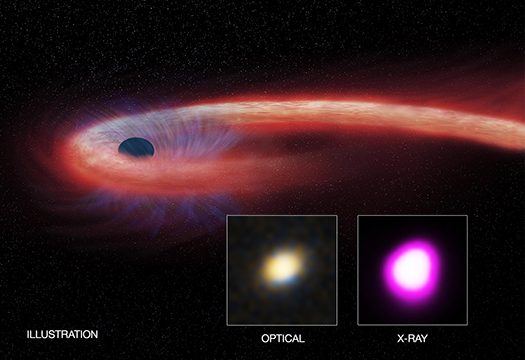Stellar Gluttony: Force-feeding a Massive Black Hole for over a Decade

Dr. Dacheng Lin
We are pleased to welcome Dr. Dacheng Lin as our guest blogger. Dacheng is the first author of a new Nature Astronomy paper that is the subject of our latest press release. This paper describes the discovery of a super-long tidal disruption event. Dacheng is a research scientist at the University of New Hampshire. After obtaining his PhD from Massachusetts Institute of Technology, he was a postdoc at IRAP, France and then at the University of Alabama. His main research interests include X-ray binaries, intermediate-mass black holes, and tidal disruption events.
Life is full of surprises and serendipity. My first time hearing about tidal disruption events (TDEs), where tidal forces from black holes rip stars apart, was in a colloquium at MIT when I just became a graduate student. At that time, as a new astronomer, I was hesitant to accept this "crazy" concept.
My involvement with TDE research began when I was a postdoc at IRAP, France. At that time, I took a long, systematic look at thousands of sources detected by a European Space Agency X-ray observatory called XMM-Newton. From that project I learned that most X-ray sources are active galactic nuclei (AGNs), which are supermassive black holes (SMBHs) at the center of galaxies that pull in – that is accrete – surrounding gas and emit copious amounts of radiation, including X-rays. Radiation from AGNs do not vary a lot because the gas surrounding them extends over a large scale and can last for tens of thousands of years.
In contrast, TDEs are relatively short-lived, lasting only for years. The long duration of AGNs results in a distinctive pattern of emission in optical spectra (i.e. the intensity of light measured at different wavelengths). This pattern is not expected in TDEs, providing a secure way to differentiate between these two classes of object. Another main difference between AGNs and TDEs is their X-ray spectra. X-ray spectra of AGNs are “hard” (that is, there are comparable amounts of high- and low-energy X-rays) and remarkably similar to each other. On the other hand, X-ray spectra of TDEs are normally expected to be “soft” (with a relatively high amount of low energy X-rays).
Therefore, an X-ray source drew my attention because it is coincident with the center of a small galaxy where we normally expect an AGN, but it showed very soft X-ray spectra. Later we obtained an optical spectrum to confirm that it is a TDE – the first one that I have ever worked on. From then on, my interest in TDEs sharply increased. TDEs allow us to find and study otherwise dormant SMBHs. They also provide a unique way to study black hole accretion physics due to their large variability.
One major part of my work now is to search for more TDEs in Chandra and XMM-Newton archival data, and my discovery of XJ1500+0154 is the result of this effort. As with my first TDE, XJ1500+154 drew my attention because of its unusually soft X-ray spectrum. Fortunately, the source had been observed quite a bit in the last 11 years, including many archival Chandra and XMM-Newton observations. We were able to obtain some new Chandra and Swift observations to get even more information on this source.
One of the most interesting things about the X-ray emission from XJ1500+0154 is that it appears to have risen fast and then remained bright for more than a decade (see the figure below). This is completely different from TDEs found before, which normally become ten times fainter in one year. While the X-ray spectrum is similar in some ways to other TDEs, it’s also slightly different because it is generally not as soft as other TDEs. But in a recent Chandra observation, the X-ray spectrum became much softer, with emission at high energies sharply suppressed. Such dramatic spectral softening has never been observed in other TDEs.
We argue that all these properties (the high luminosity, slow decay, special spectral shapes, and dramatic spectral softening) in concert suggest the presence of a prolonged super-Eddington accretion phase in our event. (The Eddington limit is defined as the balance between the outward pressure from the hot gas and the inward pull of the gravity of the black hole.) When the gas is fed/accreted to the SMBH at a rate that is not too high, the SMBH can "digest it efficiently", maximally converting the gas’ dynamic energy into radiation like X-rays. But when the feeding rate of the gas is too high (super-Eddington accretion), the radiation becomes strong enough to blow away some gas before falling into the SMBH, and some gas will just directly be swallowed by the SMBH without producing light. So the light radiated and observed is self-adjusted to a maximal level called the Eddington luminosity. Therefore the high luminosity and slow decay in our event supports a super-Eddington accretion phase.
The special spectral shape is also expected for this phase, based on our knowledge gained from observing stellar-mass black hole X-ray binaries, in which a small black hole of mass a few times that of the sun accretes mass from an orbiting star. It has been found that the X-ray spectra in the super-Eddington accretion phase in these systems show some special characteristics. The X-ray spectra of our event exhibit similar characteristics, except being about ten thousand times more luminous.
A simple but very intriguing explanation for the spectral softening is that the accretion rate decreased from being super-Eddington to sub-Eddington, a change that has been detected in stellar-mass black hole X-ray binaries. However, we cannot rule out an alternative explanation for the dramatic spectral softening: that it is caused by absorption of X-rays at high energies by high-speed outflows. Such outflows are expected when the accretion rate is around the Eddington limit. Therefore, both explanations for the spectral softening support the presence of a long super-Eddington accretion phase in the event.
To fully explain the super-long duration of our event requires the application of recent theoretical progress on the study of TDEs. In the last two years, several groups independently found that it can take a long time after the disruption of the star for the stellar debris to settle onto the accretion disk and into the SMBH. Therefore, the event can evolve much more slowly than previously thought.
To have the event last so long at such high luminosity requires full disruption of a relatively massive star, about twice the mass of the sun. Disruption of such massive stars by the SMBH is very unlikely because stars this massive are rare in most galaxies, unless the galaxy is young and actively forming stars, as in our case.
Our event has broad implications for black hole physics. One is for the distant quasars some 13 billion light years away that harbor black holes of mass about a billion times that of the sun. One popular model to explain the formation of these massive black holes in the early universe is that they had super-Eddington accretion rates and thus grew very fast at the beginning. However, the evidence that SMBHs can accrete at super-Eddington accretion rates had still been vague. Therefore, the detection of a super-long super-Eddington accretion phase in our event is significant in this aspect.
The importance of XJ1500+0154 is beyond doubt. However, the event seems extreme enough that its TDE explanation should face strict scrutiny. Fortunately, this can be achieved with continued monitoring, because based on our modeling we expect its flux to decrease by ten times in the next decade. Also, we have discovered two other events, which, though not as well observed as XJ1500+0154, exhibit similar X-ray spectra and are not AGNs based on the optical spectra of their host galaxies. Therefore, we are convinced that we have discovered a new, energetic class of TDEs.
We are clearly in an exciting moment, when more and more surveys are joining in to hunt for TDEs. With the recent discoveries of a TDE containing a jet (Swift J1644+57, also known as GRB 110328A) and an unusually nearby TDE (ASASSN-14li) and now this super-long TDE, we have good reasons to believe that many more TDE surprises are waiting for us.


